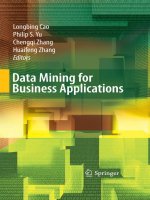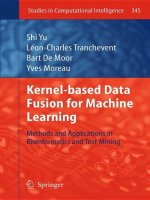IT training ebook fast data architectures for streaming applications 2 khotailieu
Bạn đang xem bản rút gọn của tài liệu. Xem và tải ngay bản đầy đủ của tài liệu tại đây (2.12 MB, 58 trang )
Co
m
pl
im
en
ts
of
Fast Data
Architectures for
Streaming Applications
Getting Answers Now from
Data Sets That Never End
2nd
Edition
Dean Wampler, PhD
SECOND EDITION
Fast Data Architectures for
Streaming Applications
Getting Answers Now from
Data Sets That Never End
Dean Wampler, PhD
Beijing
Boston Farnham Sebastopol
Tokyo
Fast Data Architectures for Streaming Applications
by Dean Wampler
Copyright © 2019 O’Reilly Media. All rights reserved.
Printed in the United States of America.
O’Reilly Media, Inc., 1005 Gravenstein Highway North, Sebastopol, CA 95472.
O’Reilly books may be purchased for educational, business, or sales promotional use.
Online editions are also available for most titles ( For more
information, contact our corporate/institutional sales department: 800-998-9938 or
Acquisitions Editor: Jonathan Hassell
Production Editor: Justin Billing
Copyeditor: Rachel Monaghan
Proofreader: James Fraleigh
October 2016:
October 2018:
Interior Designer: David Futato
Cover Designer: Karen Montgomery
Illustrator: Rebecca Demarest
First Edition
Second Edition
Revision History for the Second Edition
2018-10-15: First Release
The O’Reilly logo is a registered trademark of O’Reilly Media, Inc. Fast Data Archi‐
tectures for Streaming Applications, the cover image, and related trade dress are
trademarks of O’Reilly Media, Inc.
The views expressed in this work are those of the author, and do not represent the
publisher’s views. While the publisher and the author have used good faith efforts to
ensure that the information and instructions contained in this work are accurate, the
publisher and the author disclaim all responsibility for errors or omissions, includ‐
ing without limitation responsibility for damages resulting from the use of or reli‐
ance on this work. Use of the information and instructions contained in this work is
at your own risk. If any code samples or other technology this work contains or
describes is subject to open source licenses or the intellectual property rights of oth‐
ers, it is your responsibility to ensure that your use thereof complies with such licen‐
ses and/or rights.
This work is part of a collaboration between O’Reilly and Lightbend. See our state‐
ment of editorial independence.
978-1-492-04679-0
[LSI]
Table of Contents
1. Introduction. . . . . . . . . . . . . . . . . . . . . . . . . . . . . . . . . . . . . . . . . . . . . . . . 1
A Brief History of Big Data
Batch-Mode Architecture
2
4
2. The Emergence of Streaming. . . . . . . . . . . . . . . . . . . . . . . . . . . . . . . . . . 7
Streaming Architecture
What About the Lambda Architecture?
8
13
3. Logs and Message Queues. . . . . . . . . . . . . . . . . . . . . . . . . . . . . . . . . . . 15
The Log Is the Core Abstraction
Message Queues and Integration
Combining Logs and Queues
The Case for Apache Kafka
Alternatives to Kafka
When Should You Not Use a Log System?
15
17
19
20
22
23
4. How Do You Analyze Infinite Data Sets?. . . . . . . . . . . . . . . . . . . . . . . . 25
Streaming Semantics
Which Streaming Engines Should You Use?
26
30
5. Real-World Systems. . . . . . . . . . . . . . . . . . . . . . . . . . . . . . . . . . . . . . . . 39
Some Specific Recommendations
40
6. Example Application. . . . . . . . . . . . . . . . . . . . . . . . . . . . . . . . . . . . . . . . 43
Other Machine Learning Considerations
47
iii
7. Recap and Where to Go from Here. . . . . . . . . . . . . . . . . . . . . . . . . . . . 49
Additional References
iv
|
Table of Contents
50
CHAPTER 1
Introduction
Until recently, big data systems have been batch oriented, where data
is captured in distributed filesystems or databases and then pro‐
cessed in batches or studied interactively, as in data warehousing
scenarios. Now, it is a competitive disadvantage to rely exclusively
on batch-mode processing, where data arrives without immediate
extraction of valuable information.
Hence, big data systems are evolving to be more stream oriented,
where data is processed as it arrives, leading to so-called fast data
systems that ingest and process continuous, potentially infinite data
streams.
Ideally, such systems still support batch-mode and interactive pro‐
cessing, because traditional uses, such as data warehousing, haven’t
gone away. In many cases, we can rework batch-mode analytics to
use the same streaming infrastructure, where we treat our batch data
sets as finite streams.
This is an example of another general trend, the desire to reduce
operational overhead and maximize resource utilization across the
organization by replacing lots of small, special-purpose clusters with
a few large, general-purpose clusters, managed using systems like
Kubernetes or Mesos. While isolation of some systems and work‐
loads is still desirable for performance or security reasons, most
applications and development teams benefit from the ecosystems
around larger clusters, such as centralized logging and monitoring,
universal CI/CD (continuous integration/continuous delivery) pipe‐
1
lines, and the option to scale the applications up and down on
demand.
In this report, I’ll make the following core points:
• Fast data architectures need a stream-oriented data backplane
for capturing incoming data and serving it to consumers. Today,
Kafka is the most popular choice for this backplane, but alterna‐
tives exist, too.
• Stream processing applications are “always on,” which means
they require greater resiliency, availability, and dynamic scala‐
bility than their batch-oriented predecessors. The microservices
community has developed techniques for meeting these
requirements. Hence, streaming systems need to look more like
microservices.
• If we extract and exploit information more quickly, we need a
more integrated environment between our microservices and
stream processors, requiring fast data architectures that are flex‐
ible enough to support heterogeneous workloads. This require‐
ment dovetails with the trend toward large, heterogeneous
clusters.
I’ll finish this chapter with a review of the history of big data and
batch processing, especially the classic Hadoop architecture for big
data. In subsequent chapters, I’ll discuss how the changing land‐
scape has fueled the emergence of stream-oriented, fast data archi‐
tectures and explore a representative example architecture. I’ll
describe the requirements these architectures must support and the
characteristics of specific tools available today. I’ll finish the report
with a look at an example IoT (Internet of Things) application that
leverages machine learning.
A Brief History of Big Data
The emergence of the internet in the mid-1990s induced the cre‐
ation of data sets of unprecedented size. Existing tools were neither
scalable enough for these data sets nor cost-effective, forcing the
creation of new tools and techniques. The “always on” nature of the
internet also raised the bar for availability and reliability. The big
data ecosystem emerged in response to these pressures.
2
|
Chapter 1: Introduction
At its core, a big data architecture requires three components:
Storage
A scalable and available storage mechanism, such as a dis‐
tributed filesystem or database
Compute
A distributed compute engine for processing and querying the
data at scale
Control plane
Tools for managing system resources and services
Other components layer on top of this core. Big data systems come
in two general forms: databases, especially the NoSQL variety, that
integrate and encapsulate these components into a database system,
and more general environments like Hadoop, where these compo‐
nents are more exposed, providing greater flexibility, with the tradeoff of requiring more effort to use and administer.
In 2007, the now-famous Dynamo paper accelerated interest in
NoSQL databases, leading to a “Cambrian explosion” of databases
that offered a wide variety of persistence models, such as document
storage (XML or JSON), key/value storage, and others. The CAP
theorem emerged as a way of understanding the trade-offs between
data consistency and availability guarantees in distributed systems
when a network partition occurs. For the always-on internet, it often
made sense to accept eventual consistency in exchange for greater
availability. As in the original Cambrian explosion of life, many of
these NoSQL databases have fallen by the wayside, leaving behind a
small number of databases now in widespread use.
In recent years, SQL as a query language has made a comeback as
people have reacquainted themselves with its benefits, including
conciseness, widespread familiarity, and the performance of mature
query optimization techniques.
But SQL can’t do everything. For many tasks, such as data cleansing
during ETL (extract, transform, and load) processes and complex
event processing, a more flexible model was needed. Also, not all
data fits a well-defined schema. Hadoop emerged as the most popu‐
lar open-source suite of tools for general-purpose data processing at
scale.
A Brief History of Big Data
|
3
Why did we start with batch-mode systems instead of streaming sys‐
tems? I think you’ll see as we go that streaming systems are much
harder to build. When the internet’s pioneers were struggling to gain
control of their ballooning data sets, building batch-mode architec‐
tures was the easiest problem to solve, and it served us well for a
long time.
Batch-Mode Architecture
Figure 1-1 illustrates the “classic” Hadoop architecture for batchmode analytics and data warehousing, focusing on the aspects that
are important for our discussion.
Figure 1-1. Classic Hadoop architecture
In this figure, logical subsystem boundaries are indicated by dashed
rectangles. They are clusters that span physical machines, although
HDFS and YARN (Yet Another Resource Negotiator) services share
the same machines to benefit from data locality when jobs run.
Data is ingested into the persistence tier, into one or more of the fol‐
lowing: HDFS (Hadoop Distributed File System), AWS S3, SQL and
NoSQL databases, search engines like Elasticsearch, and other sys‐
tems. Usually this is done using special-purpose services such as
Flume for log aggregation and Sqoop for interoperating with data‐
bases.
Later, analysis jobs written in Hadoop MapReduce, Spark, or other
tools are submitted to the Resource Manager for YARN, which
decomposes each job into tasks that are run on the worker nodes,
managed by Node Managers. Even for interactive tools like Hive
4
|
Chapter 1: Introduction
and Spark SQL, the same job submission process is used when the
actual queries are executed as jobs.
Table 1-1 gives an idea of the capabilities of such batch-mode
systems.
Table 1-1. Batch-mode systems
Metric
Data sizes per job
Sizes and units
TB to PB
Time between data arrival and processing Minutes to hours
Job execution times
Seconds to hours
So, the newly arrived data waits in the persistence tier until the next
batch job starts to process it.
In a way, Hadoop is a database deconstructed, where we have explicit
separation between storage, compute, and management of resources
and compute processes. In a regular database, these subsystems are
hidden inside the “black box.” The separation gives us more flexibil‐
ity and reduces cost, but requires us to do more work for adminis‐
tration.
Batch-Mode Architecture
|
5
CHAPTER 2
The Emergence of Streaming
Fast-forward to the last few years. Now imagine a scenario where
Google still relies on batch processing to update its search index.
Web crawlers constantly provide data on web page content, but the
search index is only updated every hour, let’s say.
Suppose a major news story breaks and someone does a Google
search for information about it, assuming they will find the latest
updates on a news website. They will find nothing if it takes up to an
hour for the next update to the index that reflects these changes.
Meanwhile, suppose that Microsoft Bing does incremental updates
to its search index as changes arrive, so Bing can serve results for
breaking news searches. Obviously, Google is at a big disadvantage.
I like this example because indexing a corpus of documents can be
implemented very efficiently and effectively with batch-mode pro‐
cessing, but a streaming approach offers the competitive advantage
of timeliness. Couple this scenario with problems that are more
obviously “real time,” like location-aware mobile apps and detecting
fraudulent financial activity as it happens, and you can see why
streaming is so hot right now.
However, streaming imposes significant new operational challenges
that go far beyond just making batch systems run faster or more fre‐
quently. While batch jobs might run for hours, streaming jobs might
run for weeks, months, even years. Rare events like network parti‐
tions, hardware failures, and data spikes become inevitable if you
run long enough. Hence, streaming systems have increased opera‐
tional complexity compared to batch systems.
7
Streaming also introduces new semantics for analytics. A big sur‐
prise for me is how SQL, the quintessential tool for batch-mode
analysis and interact exploration, has emerged as a popular language
for streaming applications, too, because it is concise and easier to
use for nonprogrammers. Streaming SQL systems rely on window‐
ing, usually over ranges of time, to enable operations like JOIN and
GROUP BY to be usable when the data set is never-ending.
For example, suppose I’m analyzing customer activity as a function
of location, using zip codes. I might write a classic GROUP BY query
to count the number of purchases, like the following:
SELECT zip_code, COUNT(*) FROM purchases GROUP BY zip_code;
This query assumes I have all the data, but in an infinite stream, I
never will, so I can never stop waiting for all the records to arrive.
Of course, I could always add a WHERE clause that looks at yesterday’s
data, for example, but when can I be sure that I’ve received all of the
data for yesterday, or for any time window I care about? What about
a network outage that delays reception of data for hours?
Hence, one of the challenges of streaming is knowing when we can
reasonably assume we have all the data for a given context. We have
to balance this desire for correctness against the need to extract
insights as quickly as possible. One possibility is to do the calcula‐
tion when I need it, but have a policy for handling late arrival of
data. For some applications, I might be able to ignore the late arriv‐
als, while for other applications, I’ll need a way to update previously
computed results.
Streaming Architecture
Because there are so many streaming systems and ways of doing
streaming, and because everything is evolving quickly, we have to
narrow our focus to a representative sample of current systems and
a reference architecture that covers the essential features.
Figure 2-1 shows this fast data architecture.
8
|
Chapter 2: The Emergence of Streaming
Figure 2-1. Fast data (streaming) architecture
There are more parts in Figure 2-1 than in Figure 1-1, so I’ve num‐
bered elements of the figure to aid in the discussion that follows.
Mini-clusters for Kafka, ZooKeeper, and HDFS are indicated by
dashed rectangles. General functional areas, such as persistence and
low-latency streaming engines, are indicated by the dotted, rounded
rectangles.
Let’s walk through the architecture. Subsequent sections will explore
the details:
1. Streams of data arrive into the system from several possible
sources. Sometimes data is read from files, like logs, and other
times data arrives over sockets from servers within the environ‐
ment or from external sources, such as telemetry feeds from IoT
devices in the field, or social network feeds like the Twitter
“firehose.” These streams are typically records, which don’t
require individual handling like events that trigger state
changes. They are ingested into a distributed Kafka cluster for
scalable, durable, reliable, but usually temporary, storage. The
data is organized into topics, which support multiple producers
and consumers per topic and some ordering guarantees. Kafka
is the backbone of the architecture. The Kafka cluster may use
dedicated servers, which provides maximum load scalability
and minimizes the risk of compromised performance due to
“noisy neighbor” services misbehaving on the same machines.
Streaming Architecture
|
9
On the other hand, strategic colocation of some other services
can eliminate network overhead. In fact, this is how Kafka
Streams works, as a library on top of Kafka (see also number 6).
2. REST (Representational State Transfer) requests are often syn‐
chronous, meaning a completed response is expected “now,” but
they can also be asynchronous, where a minimal acknowledg‐
ment is returned now and the completed response is returned
later, using WebSockets or another mechanism. Normally REST
is used for sending events to trigger state changes during ses‐
sions between clients and servers, in contrast to records of data.
The overhead of REST means it is less ideal as a data ingestion
channel for high-bandwidth data flows. Still, REST for data
ingestion into Kafka is still possible using custom microservices
or through Kafka Connect’s REST interface.
3. A real environment will need a family of microservices for man‐
agement and monitoring tasks, where REST is often used. They
can be implemented with a wide variety of tools. Shown here
are the Lightbend Reactive Platform (RP), which includes Akka,
Play, Lagom, and other tools, and the Go and Node.js ecosys‐
tems, as examples of popular, modern tools for implementing
custom microservices. They might stream state updates to and
from Kafka, which is also a good way to integrate our timesensitive analytics with the rest of our microservices. Hence, our
architecture needs to handle a wide range of application types
and characteristics.
4. Kafka is a distributed system and it uses ZooKeeper (ZK) for
tasks requiring consensus, such as leader election and storage of
some state information. Other components in the environment
might also use ZooKeeper for similar purposes. ZooKeeper is
deployed as a cluster, often with its own dedicated hardware, for
the same reasons that Kafka is often deployed this way.
5. With Kafka Connect, raw data can be persisted from Kafka to
longer-term, persistent storage. The arrow is two-way because
data from long-term storage can also be ingested into Kafka to
provide a uniform way to feed downstream analytics with data.
When choosing between a database or a filesystem, keep in
mind that a database is best when row-level access (e.g., CRUD
operations) is required. NoSQL provides more flexible storage
and query options, consistency versus availability (CAP) tradeoffs, generally better scalability, and often lower operating costs,
10
|
Chapter 2: The Emergence of Streaming
while SQL databases provide richer query semantics, especially
for data warehousing scenarios, and stronger consistency. A dis‐
tributed filesystem, such as HDFS, or object store, such as AWS
S3, offers lower cost per gigabyte storage compared to databases
and more flexibility for data formats, but is best used when
scans are the dominant access pattern, rather than per-record
CRUD operations. A search appliance, like Elasticsearch, is
often used to index data for fast queries.
6. For low-latency stream processing, the most robust mechanism
is to ingest data from Kafka into the stream processing engine.
There are quite a few engines currently vying for attention, and
I’ll discuss four widely used engines that cover a spectrum of
needs.1
You can evaluate other alternatives using the concepts we’ll dis‐
cuss in this report. Apache Spark’s Structured Streaming and
Apache Flink are grouped together because they run as dis‐
tributed services to which you submit jobs to run. They provide
similar, very rich analytics, inspired in part by Apache Beam,
which has been a leader in defining advanced streaming seman‐
tics. In fact, both Spark and Flink can function as “runners” for
data flows defined with Beam. Akka Streams and Kafka Streams
are grouped together because they run as libraries that you
embed in your microservices, providing greater flexibility in
how you integrate analytics with other processing, with very low
latency and lower overhead than Spark and Flink. Kafka
Streams also offers a SQL query service, while Akka Streams
integrates with the rich Akka ecosystem of microservice tools.
Neither is designed to be as full-featured as Beam-compatible
systems. All these tools support distribution in one way or
another across a cluster (not shown), usually in collaboration
with the underlying clustering system (e.g., Kubernetes, Mesos,
or YARN; see number 10). It’s unlikely you would need or want
all four streaming engines. Results from any of these tools can
be written back to new Kafka topics for downstream consump‐
tion. While it’s possible to read and write data directly between
1 For a comprehensive list of Apache-based streaming projects, see Ian Hellström’s arti‐
cle, “An Overview of Apache Streaming Technologies”. Since this post and the first edi‐
tion of my report were published, some of these projects have faded away and new ones
have been created!
Streaming Architecture
|
11









